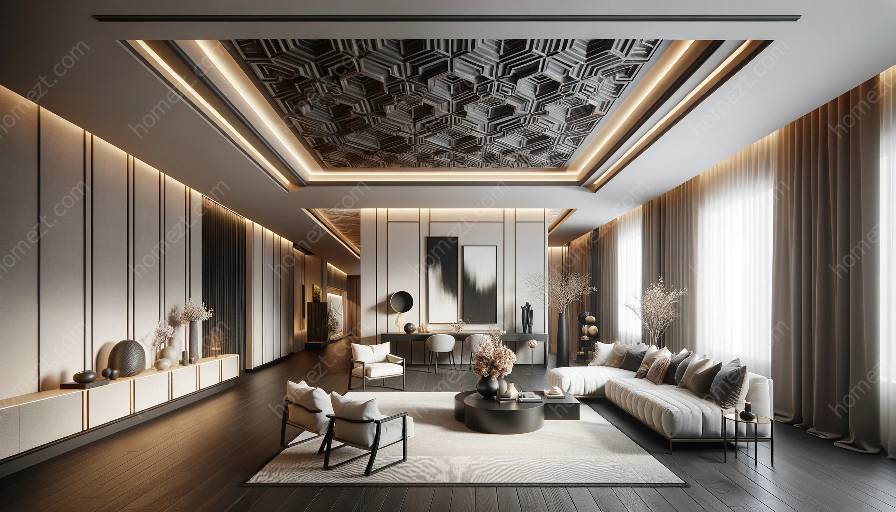Statement ceilings have become a popular trend in interior design, adding a unique touch to any room. However, when dealing with statement ceilings, it's important to consider the acoustics and soundproofing to ensure a comfortable and functional space. In this topic cluster, we will explore how acoustics and soundproofing can be integrated into statement ceiling designs, providing practical solutions and creative ideas for creating a visually attractive and acoustically effective environment.
Understanding Acoustics and Soundproofing
Before diving into the specifics of statement ceiling design, it's essential to understand the principles of acoustics and soundproofing. Acoustics deal with the transmission, reflection, absorption, and diffusion of sound waves in a given space, while soundproofing refers to the techniques used to minimize the transfer of sound between different areas. Achieving a balance between good acoustics and effective soundproofing is key to creating an ideal environment for both comfort and functionality.
Key Considerations for Statement Ceiling Design
When incorporating acoustics and soundproofing into a statement ceiling design, several key considerations need to be taken into account:
- Material Selection: Choosing the right materials for the ceiling is crucial. Opt for acoustically effective materials that also contribute to the aesthetics of the space. Consider options such as acoustic panels, sound-absorbing fabrics, or soundproofing underlayment.
- Surface Treatment: How the surface of the ceiling is treated can significantly impact its acoustical properties. Textured surfaces, perforated panels, or strategically placed acoustic elements can enhance sound diffusion and absorption.
- Integration with Decor: Balancing acoustics and soundproofing with the overall decor of the room is essential. The ceiling design should complement the existing decor while serving its functional purpose.
- Customization and Innovation: Explore innovative solutions and customization options to create a unique statement ceiling that meets both acoustical and aesthetic goals. Consider incorporating architectural elements, lighting features, or creative panel designs to enhance the overall space.
Strategies for Acoustically Effective Statement Ceilings
To achieve a statement ceiling that excels in both acoustics and soundproofing, the following strategies can be implemented:
- Strategic Acoustic Panels: Install acoustic panels on the ceiling to control reverberation and minimize sound reflections. These panels can be designed in various shapes, sizes, and colors to add visual interest to the space.
- Sound-Absorbing Materials: Choose sound-absorbing materials such as natural fibers, acoustic foam, or perforated metal to improve the overall acoustics of the room. These materials can be integrated into the ceiling design seamlessly.
- Layered Soundproofing: Implement a layered approach to soundproofing by incorporating multiple materials with different sound insulation properties. This could include using mass-loaded vinyl, resilient channels, or acoustic insulation batts.
- Acoustic Clouds and Baffles: Suspended acoustic clouds or baffles can be utilized to enhance sound diffusion and absorption in specific areas of the ceiling. These solutions not only improve acoustics but also add a striking visual element.
Decorative Enhancements for Statement Ceilings
While focusing on acoustics and soundproofing, it's equally important to consider the aesthetic appeal of the statement ceiling. Several decorative enhancements can be incorporated to elevate the overall visual impact:
- Architectural Molding and Details: Incorporate decorative molding and architectural details on the ceiling to create a sense of grandeur and elegance. These elements can be painted or highlighted to complement the room's decor.
- Integrated Lighting Solutions: Use integrated lighting features such as recessed lights, cove lighting, or decorative pendants to add depth and ambiance to the ceiling. Lighting can be a powerful tool for enhancing the overall decor.
- Artistic Finishes and Murals: Consider artistic finishes or custom-designed murals to transform the ceiling into a captivating focal point. This creative approach can add personality and character to the space.
- Visual Contrasts and Patterns: Experiment with visual contrasts, patterns, and color schemes to create a dynamic and visually engaging ceiling design. This can be achieved through paint, wallpaper, or decorative finishes.
Integration of Technology and Design
Incorporating technology into statement ceiling design can further enhance the acoustical and visual aspects of the space. Advanced sound systems, smart acoustic panels, and integrated controls can be seamlessly integrated into the design to create a multifunctional and immersive experience.
Conclusion
Acoustics and soundproofing are essential components of statement ceiling design that should not be overlooked. By carefully considering the acoustical needs of a space and integrating soundproofing solutions, it is possible to create a visually stunning ceiling that also provides optimal sound control and comfort. When combined with decorative enhancements and innovative design strategies, a statement ceiling can truly transform a room into a captivating and functional environment.






































